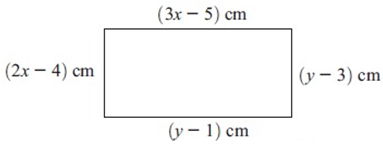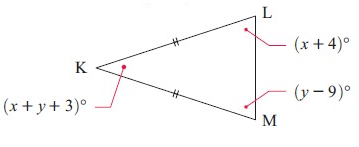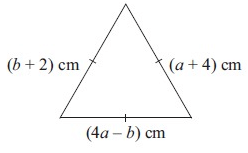SOLVIGN GEOMETRIC PROBLEMS USIGN A SYSTEM OF EQUATIONS
Subscribe to our ▶️ YouTube channel 🔴 for the latest videos, updates, and tips.
Problem 1 :
An equilateral triangle has sides of length (3x - y) cm, (x + 5) cm and (y + 3) cm. Find the length of each side.
Solution :
Let the vertices of the given triangle be ABC.
AB = 3x - y, BC = x + 5 and CA = y + 3
Since it is equilateral triangle, all sides will be equal.
AB = BC, BC = CA and CA = AB
Equating AB and BC.
3x - y
= x + 5
-y = x + 5 - 3x
-y = -2x + 5
y = 2x - 5 --- > (1)
Equating BC and CA.
x + 5 = y + 3
Applying the value of y, we get
x + 5 = 2x - 5 + 3
x - 2x = -5 - 5 + 3
-x = -7
x = 7
By applying x = 7 in (1)
y = 2(7) - 5
y = 14 - 5
y = 9
So, x = 7 and y = 9.
Problem 2 :
The figure alongside is a rectangle. Find x and y.

Solution :
|
3x - 5 = y - 1 3x - y = -1 + 5 3x - y = 4 ---> (1) |
2x - 4 = y - 3 2x - y = 4 - 3 2x - y = 1 --- > (2) |
Subtract (1)
& (2)
3x - y - 2x + y = 4 - 1
x = 3
By applying x = 3 in (1)
3(3) - y = 4
9 - y = 4
-y = 4 - 9
-y = -5
y = 5
So, x = 3 and y = 5.
Problem 3 :
KLM is an isosceles triangle. Find x and y and hence find the measure of the angle at K.

Solution :
∠K + ∠L + ∠M = 180°
x + y + 3 + x + 4 + y - 9 = 180°
2x + 2y = 180 + 9 - 7
2x + 2y = 182
Divide by 2 on both sides,
x + y = 91 --- > (1)
Since KL = KM, ∠L = ∠M
x + 4 = y - 9
y - x = 13 --- > (2)
Add (1) & (2), we get
x + y - x + y = 91 + 13
2y = 104
y = 52
By applying y = 52 in (1)
x + 52 = 91
x = 91 - 52
x = 39
Now, ∠K = x + y + 3
∠K = 39 + 52 + 3
∠K = 94°
Problem 4:
Given that the triangle alongside is equilateral, find a and b.

Solution :
Since the given triangle is equilateral triangle, the sides will be equal.
(b + 2) cm, (a + 4) cm and (4a - b) cm
The all sides of equilateral triangle are equal
|
a + 4 = b + 2 a - b = 2 - 4 a - b = -2 --- > (1) |
b + 2 = 4a - b 4a - b - b = 2 4a - 2b = 2 2a - b = 1 --- > (2) |
Subtract (1) & (2)
a - b - 2a + b = -2 - 1
-a = -3
a = 3
By applying a = 3 in (1)
3 - b = -2
-b = -2 - 3
-b = -5
b = 5
So, a = 3 and b = 5.
Problem 5 :
A rectangle has perimeter 32 cm. if 3 cm is taken from the length and added to the width, the rectangle becomes a square. Find the dimensions of the original rectangle.
Solution :
Let length and width be L and W respectively.
2L + 2W = 32 --- > (1)
L - 3 = W + 3
L = W + 6
Substitute L = W + 6 in (1)
2(W + 6) + 2W = 32
2W + 12 + 2W = 32
4W + 12 = 32
4W = 32 - 12
4W = 20
W = 20/4
W = 5
By applying W = 5 in L = W + 6
L = 5 + 6
L = 11
So, original dimension of rectangle, length is 11 cm and width is 5 cm.
Subscribe to our ▶️ YouTube channel 🔴 for the latest videos, updates, and tips.
Recent Articles
-
Finding Range of Values Inequality Problems
May 21, 24 08:51 PM
Finding Range of Values Inequality Problems -
Solving Two Step Inequality Word Problems
May 21, 24 08:51 AM
Solving Two Step Inequality Word Problems -
Exponential Function Context and Data Modeling
May 20, 24 10:45 PM
Exponential Function Context and Data Modeling